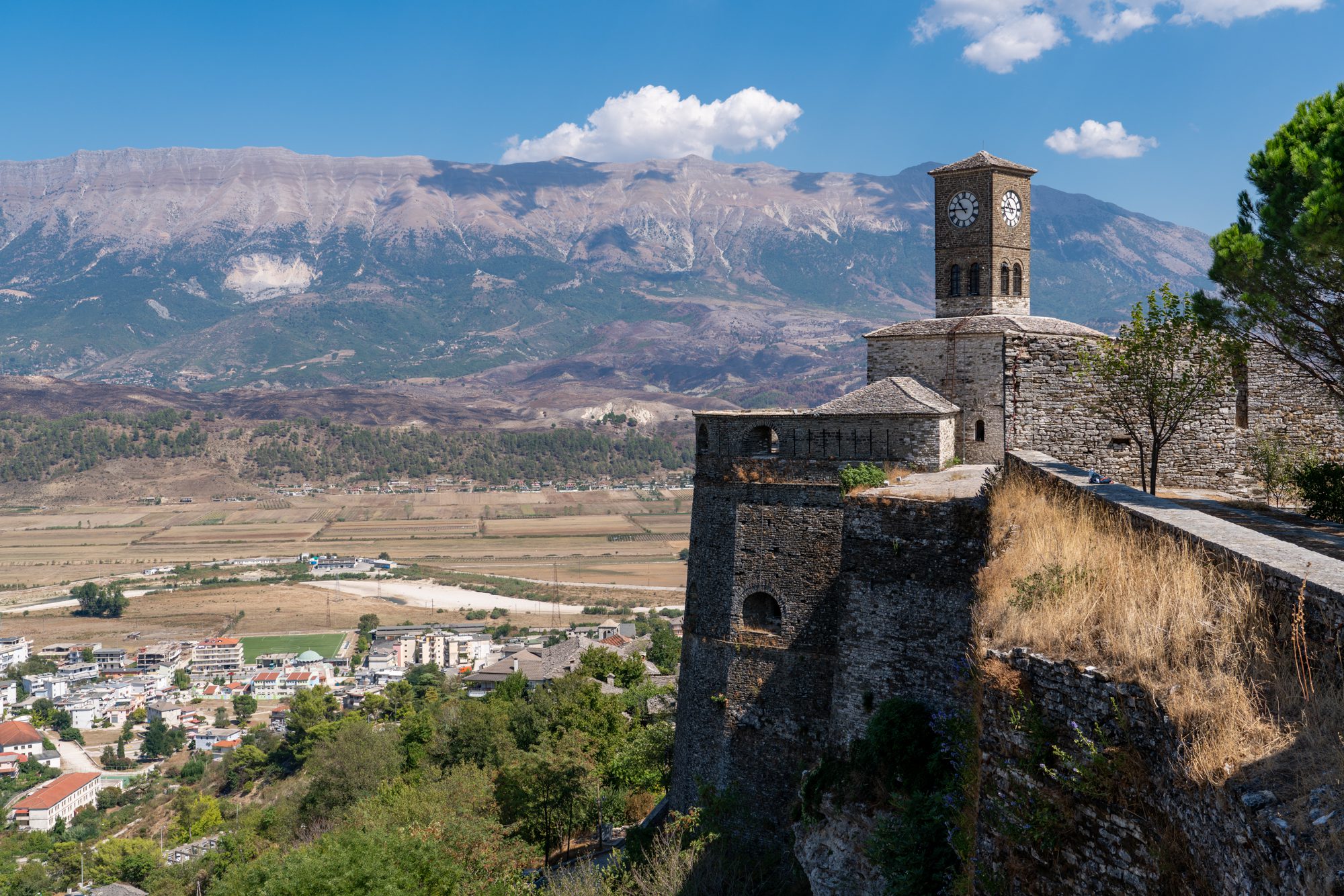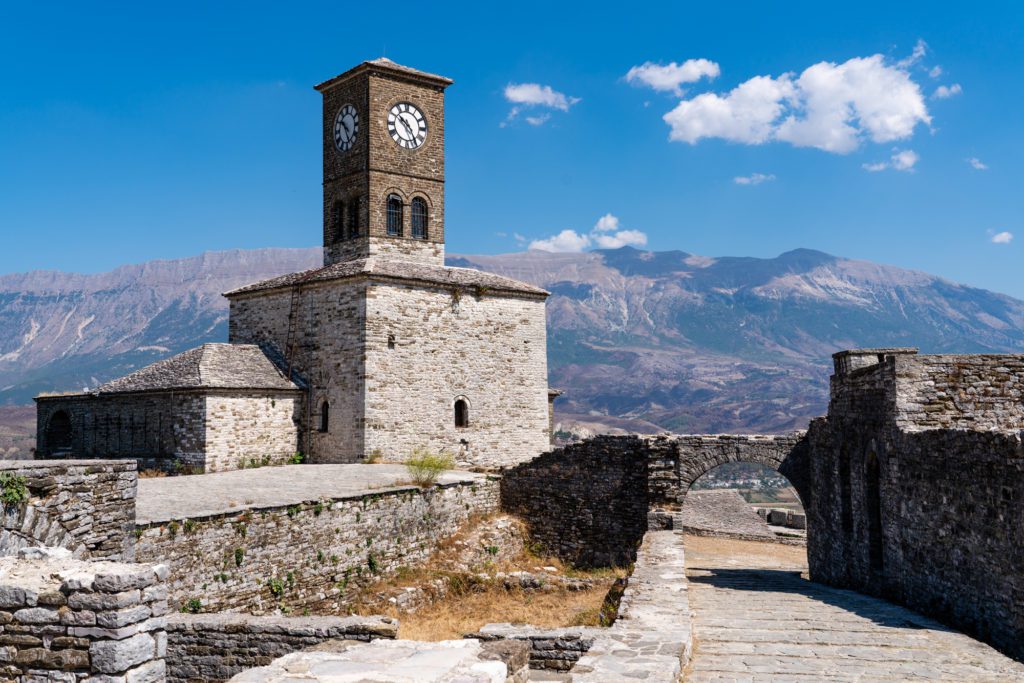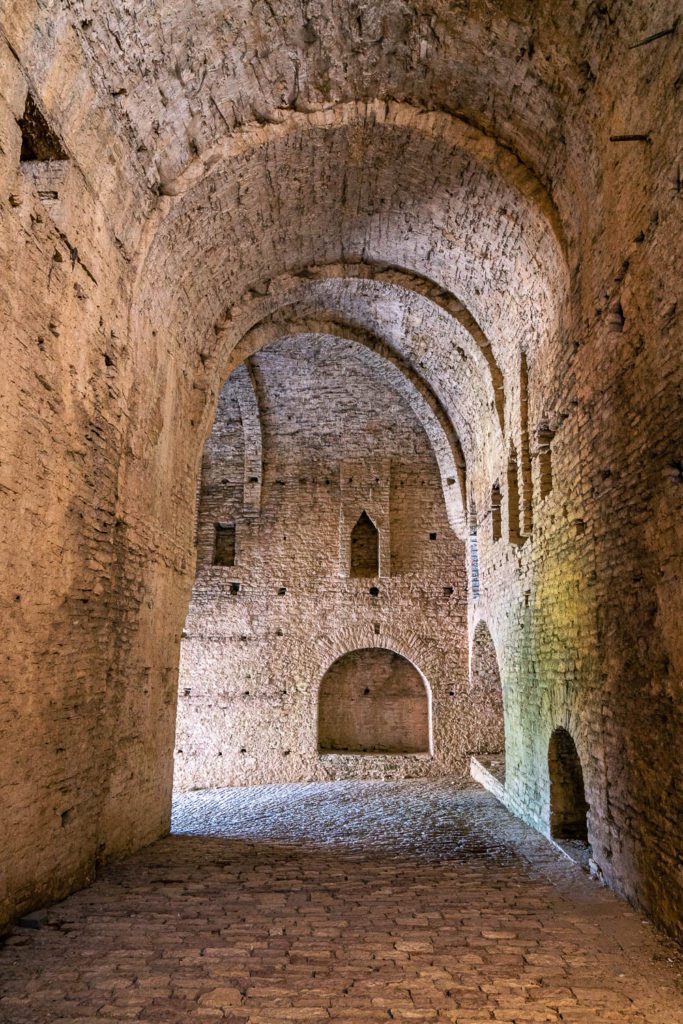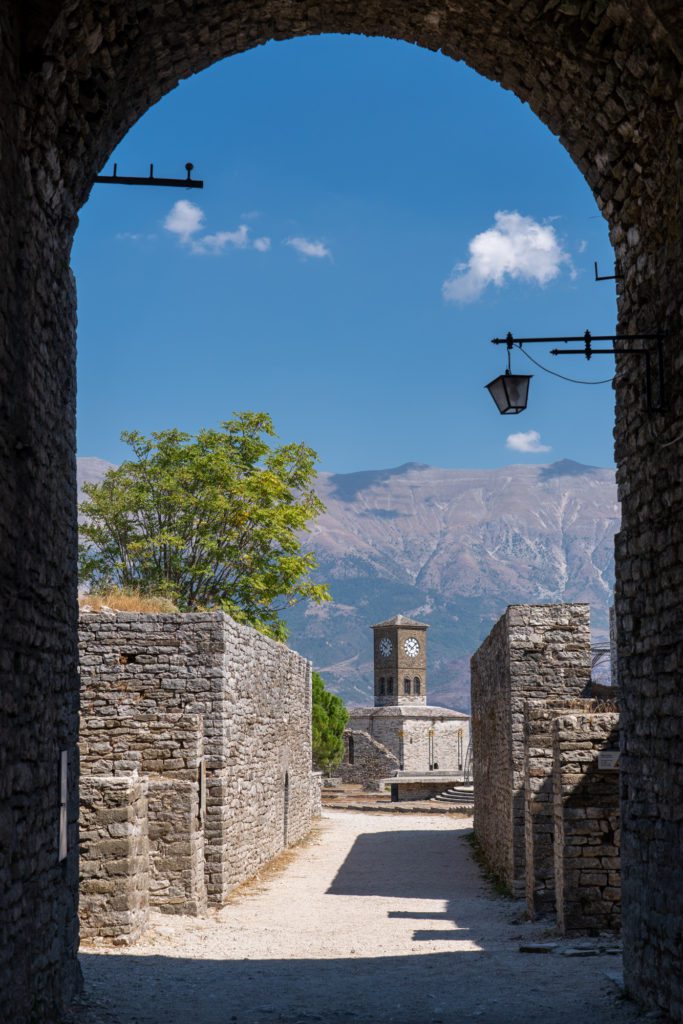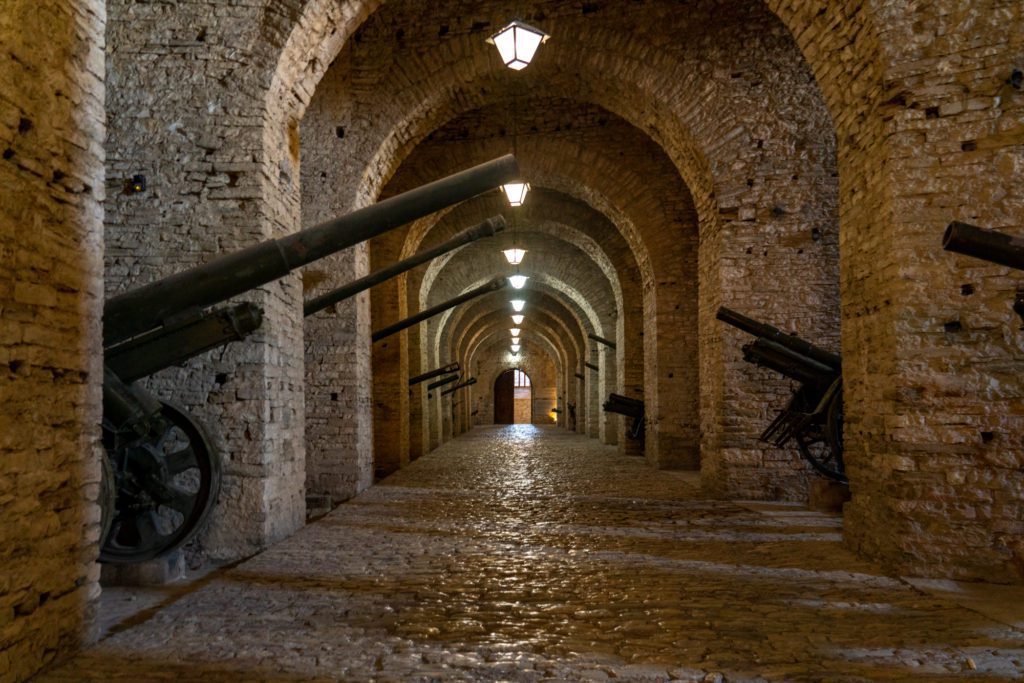Introduction
Gjirokaster (in Albanian: Gjirokastra or Gjirokastër) is my favorite city in Albania, full stop. The walkable old town, majestic manor homes, and the imposing castle on the hill above, all contribute to make the Stone City of Gjirokaster, Albania’s must-visit destination.
The city’s name first appears in the historical record in the mid 1300’s as Argyrocastron, medieval Greek for the ‘silver castle,’ but the settlement has been around for much longer. Archeological evidence shows people have been in the area since at least 2000 BCE! The iconic stone walls of the castle were constructed from the 6th to 12th centuries and the castle has stood watch over the valley below ever since.
Many tourists skip Gjirokaster, passing it by for more time on the coast. But they miss out on a wonderful place to spend a few days. I visited the city twice on my three weeks in country, first on my own, and then a week later with friends and loved it both times. Spare at least 2 days (or even better 3!) for your time in Gjirokaster.

Old Town
Described by the UNESCO World Heritage committee as “a rare example of a well-preserved Ottoman town, built by farmers of large estate,” Gjirokaster’s old town appears like a quaint fairy tale village. The narrow stone-paved streets, the window box-lined balconies, and artisan work studios add to the idyllic setting.
The old town area dates mainly to the 17th to 19th centuries and is the location of the shopping district now known as the Old Bazaar. Woodworking artisans, local wine purveyors, and tourist trinkets can be discovered around every bend. I enjoyed browsing the rug merchants who had their wares laid out on the cobblestone streets.

This area is also home to most of the best restaurants and cafes in town. I particularly enjoyed comparing and contrasting each venue’s attempt at the local specialty of Qifqi (cheef – chee). This dish is made by mixing cooked rice and whipped raw eggs with mint powder, black pepper, and salt. Formed into little balls, they are fried until lightly golden in color. My favorites also had cheese inside! Find them at Kujtim Restaurant in Old Town.
If you need a little break from exploring, check out the cafe built under the central mosque in the old town. Te Kubé is housed within the vaults that hold up the stately Bazar Mosque. Top quality Albanian coffee, fresh made juices, and yummy sweets plus the fastest internet in town made Te Kubé a must-visit spot for me. I spent several afternoons working here and taking conference calls.
The Citadel
If you do only one thing in Gjirokaster (but how could you?), do not miss the castle. With its 360 degree view of Old Town, the new town, the valley below, and the hills above, the citadel is visible from everywhere. The castle has been gradually expanded upon since its initial construction in the 12th century.
Its halls and gardens contain tanks, gunnery equipment, and even a downed American warplane. Be sure to visit the clock tower built in the 19th century, the castle walls for unrestricted views, the hall of armaments, and the parade grounds (on my second visit here there was a Miss Teen Eastern Europe competition ongoing, ha!).
If you are a history buff, there are two museums located within the castle for an additional fee of 200 lek (which covers both museums). The first, The Museum of Gjirokastra, is fantastic and covers the archeological history of the city and region from antiquity to the communist era. The second, the National Museum of Armaments, occupies the former prison where inmates were “reeducated.” Built by King Zod of Albania (and yes that really was his name), for political prisoners, it was later used by the Communist regime up until 1968. This museum is intense and mostly filled with an obscene amount of weaponry and little to no written context.
Don’t miss the Museum of Gjirokastra, but unless you are an extreme war buff, the Museum of Armaments can be missed. Allow 2-3 hours to visit the castle (+1.5 hours extra if visiting the museums). Entrance costs 400 lek ($3.75).
The Manor Houses
More than 500 historical homes have been deemed cultural monuments by the UNESCO World Heritage program. The most iconic are those of the stone fortresses that were built by the most wealthy and prominent families of Gjirokaster in the 17th, 18th, and 19th centuries.
If you have time to only visit one of the manor houses, make it Zekate House. Easily the most imposing and impressive building in Gjirokaster, the house was built in 1811. It was constructed by Beqir Zeko, a general administrator under commander Ali Pasha. It features two fortified towers, two vaulted arches at the entrance, three internal stories, a still-functional gutter and cistern system, and period decoration. Members of the Zekate family are on hand to give a guided tour of the home from 9-5pm daily. Allow 30 minutes for the tour and visit. Entrance is 200 lek ($1.90).
If you have time, another well-preserved manor home is the Skenduli House. Unlike the Zekate, it does not include a tour as the keeper speaks no English. For this reason, visit the Skenduli second as you will appreciate the design and history much more as the printed signs in the second house leave much to be desired. Allow 15 minutes for the visit if it is your second manor house. Entrance is also 200 lek ($1.90).
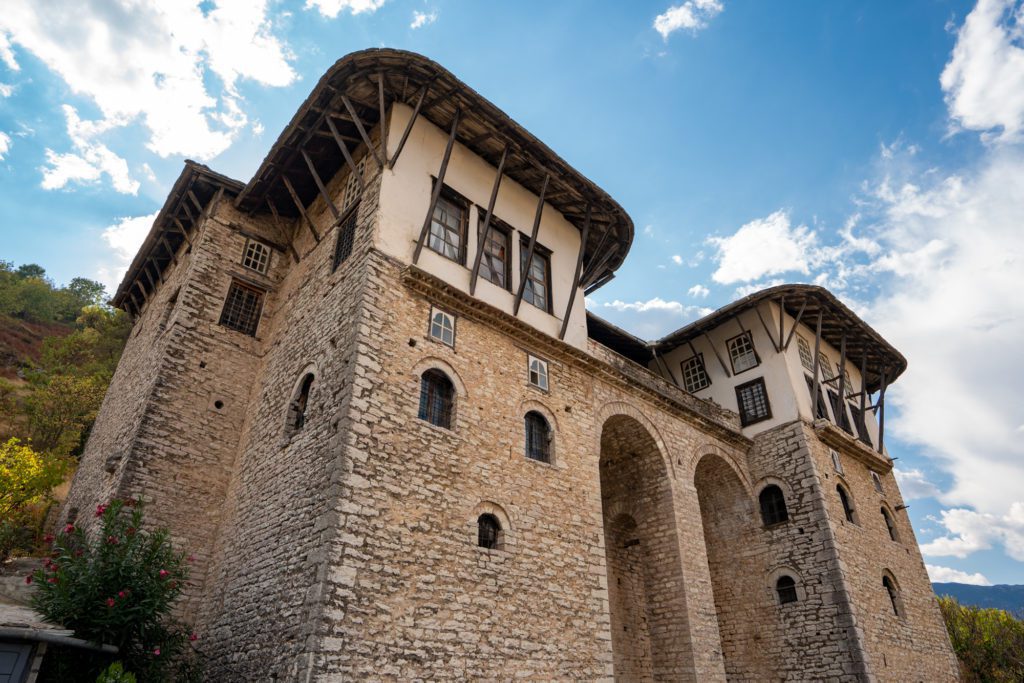
Ali Pasha Bridge
If you are looking to do something a bit more heart-pumping, there is a wonderful hike that takes you up through the old neighborhoods and along a shepherd path to the old stone Ali Pasha Bridge. This structure was not built as a foot bridge, but rather was commissioned by the Ottoman ruler to serve as an aqueduct to direct water to the castle. Much of the original stone was removed to be used within the castle walls during the Communist era.
Expect to take 45 minutes from town for the hike to the bridge. If you can time your arrival for 5pm, you will likely encounter the shepherds returning their flock across the span back to town. Be sure to wear sturdy shoes as the trail is slick rock. Returning to town should take only about 20 minutes.
NomadTip
Use Maps.Me to pinpoint the exact coordinates. The app provides good hiking directions that are easy to follow!

Where I stayed
As I mentioned above, I visited Gjirokaster on two separate occasions during my time in Albania. Both times I stayed in the old town area and would highly suggest you base yourself there as most of the top sights are easily within walking distance.
Budget: My favorite budget option in town is Stone City Hostel – Hostelworld’s top rated Albanian hostel for three years running (2018, 2019, 2020). The entire team there is friendly, helpful, and incredibly knowledgeable about the area. The owners prepare one of the best breakfast spreads I’ve ever encountered in a hostel. They also occasionally host walking tours of Gjirokaster.
NomadReview
Stone City Hostel
What’s Hot
- Top rated hostel in Albania
- Amazing breakfast spread daily
- Nice communal living room and courtyard
- Centrally located
What’s Not
- Only two private rooms available
- Dorms are right next to living room, may be noisy
Midrange: Hotel Kastro is located in Old Town, just a few blocks away from the main crossroads of the Old Bazaar. The hotel receives top marks for its breakfast, traditional architecture, and wonderful staff. Prices start from $40 for a double room.
Luxury: Kerculla Resort is stunning. It is perched high above town and features incredible views from most parts of the hotel as well as one of the only pools in the Old Town area. As it is quite a ways above the rest of Gjirokaster, a taxi is absolutely necessary. Priced from $69 for a double room.
Getting to Gjirokaster
By bus: On my first visit, I arrived in Gjirokaster via Berat. The trip took 3 hours and cost 900 lek ($8.40). If you are coming from Tirana, the bus will take 4 hours and cost 1000 lek ($9.30). From Sarandë, expect the trip to take 1 hour and cost 300 lek ($2.80).
If you travel by bus, know that they will drop you off in the new town along the main highway. You have three options to get up to the old town from there. If you are feeling adventurous, you can hike the 1.3km (0.8mi) distance and 100m (325ft) elevation gain. You can alternatively take the city bus like I did for 30 lek ($0.25) or flag down a taxi for 300 lek ($2.50).
NomadTip
If you do decide to take a taxi, head a few blocks west on Bulevardi 18 Shtatori so you don’t pay the overly exorbitant fares quoted at the bus stop.
By car: After hearing horror stories about the state of roads in Albania from other travelers, I can confirm that there no longer seems to be any cause for concern. It is possible that this is a recent development, but I was pleasantly surprised everywhere I went via rental car. That said, many Albanians seem to be quite reckless while driving, so if you do decide to rent a car, drive defensively! The road from Tirana to Gjirokaster is a major highway. The trip should take 3.25 hours. If you are coming from Sarandë by car, the trip should take 1 hour.
Albania’s most beautiful city
Three days and two nights would be a great introduction to Albania’s most beautiful city. Take time to explore its labyrinthine streets, hike to the Ali Pasha Bridge, visit the historical castle, and eat local specialties at its many great restaurants.
Gjirokaster is a wonderful sampler of the many traits that make Albania such a joy to experience. Add the stone city to your itinerary and you will not be disappointed.
